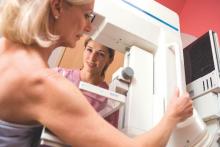Breast density is an important factor in determining the appropriate screening intervals for mammography after age 50 years, according to a report published online Aug. 22 in Annals of Internal Medicine.
Researchers from the Cancer Intervention and Surveillance Modeling Network, collaborating with the Breast Cancer Surveillance Consortium, assessed three separate, well-established microsimulation models that used different structures and underlying assumptions but the same data input to estimate the benefits and harms of various screening intervals. They applied the models to two hypothetical populations: Women aged 50 years and older who were initiating screening for the first time and women aged 65 years who had undergone biennial screening since age 50 years.
The models incorporated national data regarding breast cancer incidence, treatment efficacy, and survival. They assessed patient risk by including numerous factors, such as menopausal status, obesity status, age at menarche, nulliparity, and previous biopsy results, but didn’t include family history or genetic testing results. Screening strategies were compared among four possible breast-density levels, according to the American College of Radiology’s Breast Imaging Reporting and Data System (BI-RADS).
The principal finding was that two factors – breast density and risk for breast cancer – were key to determining the optimal screening interval. The optimal interval was the one that would yield the highest number of benefits (breast cancer deaths averted, life-years gained, and quality-adjusted life-years gained) while yielding the lowest number of harms (false-positive mammograms, benign biopsies, and overdiagnosis).
“For average-risk women in low-density subgroups, who comprise a large portion of the population, triennial screening provides a reasonable balance of benefits and harms and is cost effective. Annual screening has a favorable balance of benefits and harms and would be considered cost effective for subgroups of women ... with risk levels that are two to four times the average and with heterogeneously or extremely dense breasts,” the researchers wrote (Ann.Intern Med. 2016 Aug 22. doi: 10.7326/M16-0476).
After age 50 years, annual mammography was more beneficial than harmful only in two subgroups of women: those with greater breast density and those with higher risk for breast cancer. Such women are estimated to comprise less than 1% of the general population at both age 50 years and age 65 years. In contrast, biennial and even triennial mammography yielded fewer false-positives and fewer biopsies for average-risk women with low-density breasts without affecting the number of breast cancer deaths averted, the researchers noted.
The study was supported by grants from the National Institutes of Health and several state public health departments and cancer registries in the United States. The researchers reported receiving grants and other support from the NIH, the American Society of Breast Surgeons, Renaissance Rx, Ally Clinical Diagnostics, the Netherlands National Institute for Public Health and the Environment, SCOR Global Risk Center, and Genomic Health Canada.


